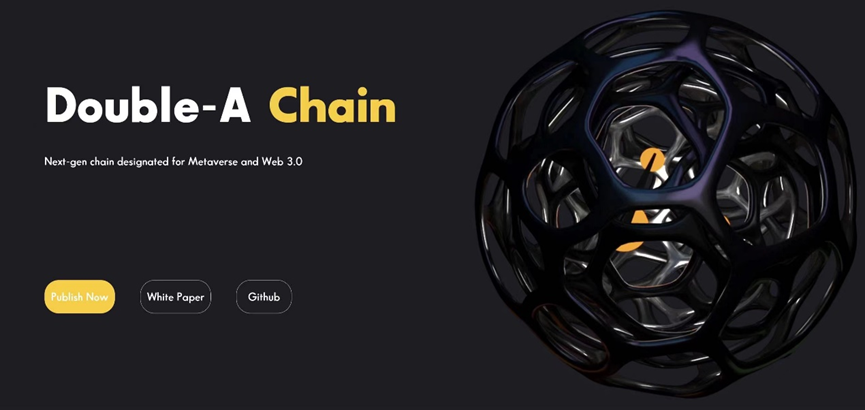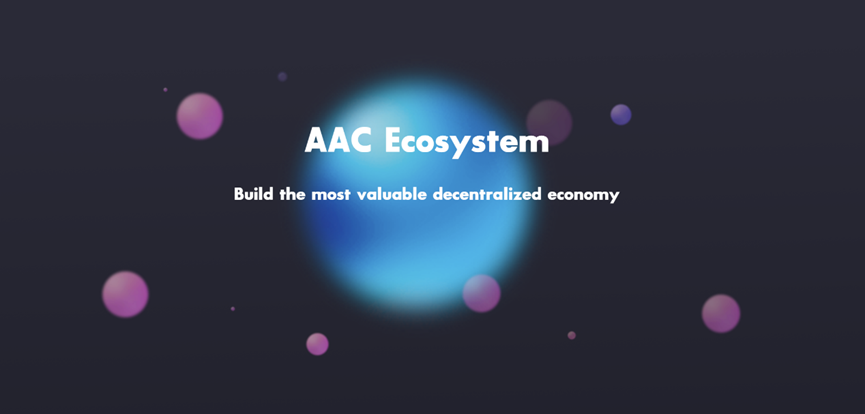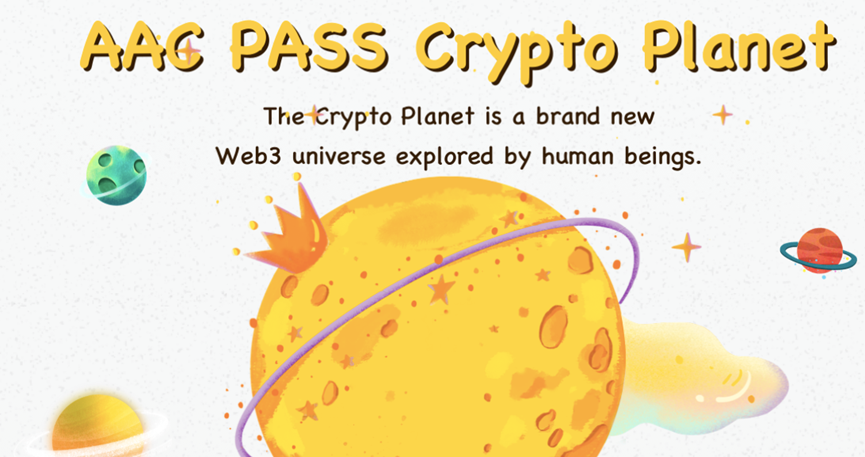Double-A Chain: An Efficient and User-Friendly Next-Generation Public Chain

Double-A Chain is a next-generation public chain characterized by decentralization, high transaction speed, and low fees. AAC is the token of Double-A Chain, which adopts the APoS consensus mechanism, is compatible with smart contracts, and supports high-performance transactions.
Double-A Chain is committed to providing development and ecosystem solutions for Metaverse and Web3.0 applications, offering scalability and excellent user experience for DApps and web applications in the Metaverse and Web3.0. Additionally, Double-A Chain focuses on addressing the scalability and usability issues faced by current blockchains. By providing support such as wallet integration, payment APIs and SDKs, products, and identity solutions, developers can design, implement, and migrate DApps built on platforms like Ethereum to Double-A Chain while maintaining decentralization.
Specifically, Double-A Chain's vision encompasses the following aspects:
1. Building an Efficient and User-Friendly Blockchain Infrastructure
Double-A Chain aims to address the network congestion and rising gas fees issues faced by current public chains like Ethereum. Through technological innovation, it seeks to build an efficient and user-friendly blockchain infrastructure to accelerate the success of the Metaverse, Web3.0, and other digital revolutions.
2. Exploring the Metaverse and Web3.0 Space
Double-A Chain recognizes the Metaverse and Web3.0 as the future trends of the digital world and essential drivers of societal, cultural, and economic transformation. Therefore, the project aims to explore these two domains deeply and provide support and assistance to developers and innovative projects within these fields.
3. Becoming a Birthplace of Blockchain Technological Innovations
Double-A Chain aspires to become a birthplace for blockchain technological innovations. It aims to attract more developers and innovative projects to join its ecosystem and provide the necessary resources and support to foster continuous innovation and development in blockchain technology.
4. Establishing a Comprehensive Ecosystem Cycle
Double-A Chain aims to build a comprehensive ecosystem encompassing technological development, application promotion, and asset trading. By doing so, it will facilitate the sustained growth and prosperity of the community and provide high-quality services to a broader range of developers and users.
To achieve these visions, Double-A Chain adheres to the following design principles:
1. Independent Blockchain
Double-A Chain is an independent blockchain rather than a layer-two solution to ensure complete technical independence.
2. Ethereum Compatibility
While Double-A Chain is an independent blockchain, it chooses to be compatible with the existing Ethereum mainnet to ensure interoperability with the existing ecosystem components and tools, catching up with Ethereum in terms of performance, ecosystem, and other aspects.
3. Consensus and Governance
Double-A Chain adopts a Staking-based consensus mechanism and combines other governance methods to enhance network performance and community governance integrity.
4. Cross-Chain Communication
Double-A Chain supports cross-chain communication between different blockchains to enable the circulation of digital assets and utilizes bidirectional, decentralized, and trustless communication protocols.
The mission of Double-A Chain is to become the next-generation efficient and user-friendly blockchain infrastructure. It aims to not only be a public chain but also prioritize support for and exploration of high-potential developers and innovative projects in the Metaverse and Web3.0. Double-A Chain aims to leverage its ecosystem to become a birthplace of blockchain technological innovations, particularly in the realms of the Metaverse and Web3.0. Additionally, the project is dedicated to establishing a comprehensive ecosystem cycle encompassing technological development, application promotion, and asset trading.
APoS Consensus Mechanism

Double-A Chain adopts the APoS (Authority Proof of Stake) consensus mechanism, which combines PoA (Proof of Authority) and DPoS (Delegated Proof of Stake), and is governed by both validator nodes and voters. This consensus mechanism is characterized by low transaction costs, low latency, and high transaction concurrency, supporting a maximum of 21 validators.
Among them, validators are responsible for packaging blocks for on-chain transactions, with a total of 21 validators. Additionally, candidate nodes need to stake at least 10 million AAC tokens and obtain votes from at least 100 users, ranking between 22nd and 32nd. The system manages the current validators through smart contracts, including validator ranking management, staking and unstaking operations, and block reward distribution.
While the PoA protocol provides the ability to defend against 51% attacks, it has been criticized as being more centralized than PoW due to validators having complete power and being susceptible to corruption and security attacks. DPoS allows token holders to vote and elect validators, achieving decentralization and facilitating community governance. Therefore, Double-A Chain proposes to combine DPoS and PoA to achieve a new consensus mechanism, namely the APoS consensus mechanism.
This mechanism can avoid the security issues of PoA while also realizing the advantages of DPoS. Each validator needs to stake 10 million AAC tokens and obtain votes from at least 100 users to become a candidate node. Then, at the end of each epoch, the active validators are updated based on their rankings. The APoS consensus mechanism has the following characteristics:
1. Low transaction costs: With a smaller number of validators and no mining rewards, transaction costs are relatively low.
2. Low latency: With a smaller number of validators, transaction speeds are faster, resulting in lower transaction latency.
3. High transaction concurrency: It supports multiple concurrent transactions, improving transaction processing efficiency.
4. Supports a maximum of 21 validators: Controlling the number of validator nodes within 21 enhances network security and decentralization.
Economic Model
The token of Double-A Chain is AAC, with a total supply of 12 billion tokens. The annual increase in supply will be an additional 5% (6 billion tokens). These extra AAC tokens will be allocated to the node reward pool and distributed according to the rules of node rewards.
1. Allocation Mechanism
The allocation mechanism for AAC is as follows:
The total supply of AAC is 12 billion tokens. The specific allocation is as follows:
(1) NFT Staking Lockup: 2 billion tokens
(2) Market Circulation: 2 billion tokens
(3) Mining Pool Allocation: 8 billion tokens. Mining started in April 2023, with a maximum supply of 1.6 billion tokens in the first year, decreasing by 20% each year thereafter.
2. The annual additional issuance of 600 million AAC tokens will be allocated to the node reward pool, and the specific allocation mechanism will follow the rules of "Node Rewards."
(1) The allocation of the 8 billion mining pool tokens is as follows:
Super Nodes: 8%, totaling 640 million tokens
Alliance Nodes: 20%, totaling 1.6 billion tokens
Public Mining Pool: 60%, totaling 4.8 billion tokens (for AAC market users)
Foundation Mining Pool: 10%, totaling 800 million tokens
Promotion Mining Pool: 2%, totaling 160 million tokens
(2) The allocation of the annual additional issuance of 600 million AAC tokens in the reward pool is as follows:
49% of the bonus pool will be distributed to node administrators based on the proportion of votes received by validators.
40% of the bonus pool will be distributed to voting users based on the proportion of votes received by validators.
11% of the bonus pool will be evenly distributed to all candidate nodes and users. If the number of candidate nodes is less than 11, the reward for this portion will be reduced to {bonus pool amount x 1% x actual number of candidate nodes}.
Token Use-Cases
AAC is the token of Double-A Chain and can be used for staking, voting governance, and future payment methods within the ecosystem. When users send AAC or use Double-A Chain applications, they need to pay small amounts of AAC as fees, which incentivizes nodes to process and verify user transactions.
Additionally, AAC will serve as a medium of exchange in the future on-chain ecosystem marketplace, acting as a settlement tool for applications and circulation markets in scenarios such as Metaverse, Web3.0, and GameFi within Double-A Chain. Double-A Chain will also establish an AAC Incubation Fund to support the development and operation of Metaverse projects through investments, technology, and market support.
AAC Booming Plan
At the end of 2022, Double-A Chain launched the AAC Booming Plan to foster ecosystem prosperity. In the first phase of the Booming Plan, the AAC PASS was introduced as the first equity-based NFT project on the public chain. It aims to enhance community consensus and lock a portion of AAC token circulation by offering AAC rewards and multiple benefits for NFT staking. Within the AAC PASS project, the National PASS represents the highest level of NFT privileges. There will be a limited global issuance of 197 National PASS NFTs, and each NFT requires staking 10 million AAC tokens. The staking period for the NFT is one year.

AAC HK Plus - The Second Phase of the Booming Plan, a Major Upgrade for the Public Chain in 2023
In late April 2023, AAC HK Plus will be officially launched, marking a significant upgrade for AAC and ushering in a new era of decentralized governance. AAC enters a new epoch with a total supply of 8 billion tokens in the HK Plus mining pool. After mining begins in April 2023, the maximum supply in the first year will be 1.6 billion tokens, followed by a 20% reduction each subsequent year.
Rights and Responsibilities of HK Plus Mining Pool Nodes:
(1) HK Plus mining pool nodes do not need to package blocks or maintain the main chain.
(2) All mining pool nodes earn corresponding rewards through PoS+DPoS consensus mechanism staking.
(3) Mining pool nodes can receive referral rewards by inviting others to participate in staking mining.
(4) Mining pool nodes have the flexibility to enter or exit the mining pool 24/7, 365 days a year.
Conclusion:
Double-A Chain is an efficient and user-friendly next-generation public chain characterized by decentralization, high transaction speed, and low fees. Its vision includes building an efficient and user-friendly blockchain infrastructure, exploring the realms of Metaverse and Web3.0, becoming a birthplace of blockchain technological innovation, and establishing a comprehensive ecosystem cycle. To achieve these visions, Double-A Chain adheres to design principles such as an independent blockchain, Ethereum compatibility, consensus and governance, and cross-chain communication, while employing the APoS consensus mechanism.
Furthermore, AAC serves as the token of Double-A Chain and can be used for staking, voting governance, and future payment methods within the ecosystem. AAC will also act as a medium of exchange in the future on-chain ecosystem marketplace, serving as a settlement tool for applications and circulation markets in scenarios such as Metaverse, Web3.0, and GameFi within Double-A Chain. Additionally, Double-A Chain will establish an AAC Incubation Fund to support the development and operation of Metaverse projects through investments, technology, and market support.


All Comments